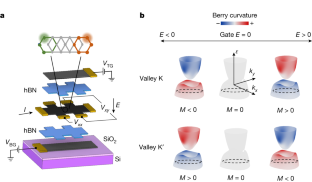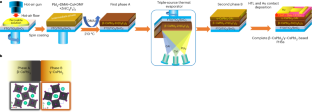2023-10-19 ペンシルベニア州立大学(PennState)
◆研究者たちは、QAH効果を示す材料を最適化し、5ミリ秒の電流パルスを適用することで電子の流れ方向を変える方法を見つけました。これにより、量子状態の書き込みと読み取りが向上し、電子の流れの効率的な制御が可能になります。これにより、高容量のデータストレージデバイスや量子コンピュータの発展が期待されています。
<関連情報>
- https://www.psu.edu/news/eberly-college-science/story/electrical-control-quantum-phenomenon-could-improve-future-electronic/
- https://www.nature.com/articles/s41563-023-01694-y
- https://journals.aps.org/prl/abstract/10.1103/PhysRevLett.130.086201
量子異常ホール絶縁体におけるエッジ電流キラリティの電気的スイッチング Electrical switching of the edge current chirality in quantum anomalous Hall insulators
Wei Yuan,Ling-Jie Zhou,Kaijie Yang,Yi-Fan Zhao,Ruoxi Zhang,Zijie Yan,Deyi Zhuo,Ruobing Mei,Yang Wang,Hemian Yi,Moses H. W. Chan,Morteza Kayyalha,Chao-Xing Liu & Cui-Zu Chang
Nature Materials Published:19 October 2023
DOI:https://doi.org/10.1038/s41563-023-01694-y

Abstract
A quantum anomalous Hall (QAH) insulator is a topological phase in which the interior is insulating but electrical current flows along the edges of the sample in either a clockwise or counterclockwise direction, as dictated by the spontaneous magnetization orientation. Such a chiral edge current eliminates any backscattering, giving rise to quantized Hall resistance and zero longitudinal resistance. Here we fabricate mesoscopic QAH sandwich Hall bar devices and succeed in switching the edge current chirality through thermally assisted spin–orbit torque (SOT). The well-quantized QAH states before and after SOT switching with opposite edge current chiralities are demonstrated through four- and three-terminal measurements. We show that the SOT responsible for magnetization switching can be generated by both surface and bulk carriers. Our results further our understanding of the interplay between magnetism and topological states and usher in an easy and instantaneous method to manipulate the QAH state.
量子異常ホール絶縁体における閉じ込め誘起キラルエッジチャネル相互作用 Confinement-Induced Chiral Edge Channel Interaction in Quantum Anomalous Hall Insulators
Ling-Jie Zhou, Ruobing Mei, Yi-Fan Zhao, Ruoxi Zhang, Deyi Zhuo, Zi-Jie Yan, Wei Yuan, Morteza Kayyalha, Moses H. W. Chan, Chao-Xing Liu, and Cui-Zu Chang
Physical. Review Letters Published 21 February 2023
DOI:https://doi.org/10.1103/PhysRevLett.130.086201
ABSTRACT
In quantum anomalous Hall (QAH) insulators, the interior is insulating but electrons can travel with zero resistance along one-dimensional (1D) conducting paths known as chiral edge channels (CECs). These CECs have been predicted to be confined to the 1D edges and exponentially decay in the two-dimensional (2D) bulk. In this Letter, we present the results of a systematic study of QAH devices fashioned in a Hall bar geometry of different widths under gate voltages. At the charge neutral point, the QAH effect persists in a Hall bar device with a width of only ∼72 nm, implying the intrinsic decaying length of CECs is less than ∼36 nm. In the electron-doped regime, we find that the Hall resistance deviates quickly from the quantized value when the sample width is less than 1 μm. Our theoretical calculations suggest that the wave function of CEC first decays exponentially and then shows a long tail due to disorder-induced bulk states. Therefore, the deviation from the quantized Hall resistance in narrow QAH samples originates from the interaction between two opposite CECs mediated by disorder-induced bulk states in QAH insulators, consistent with our experimental observations.



